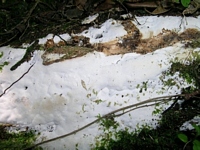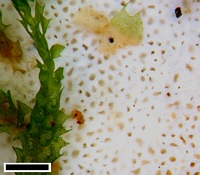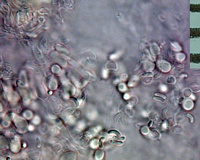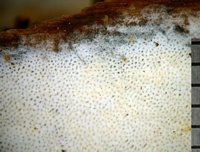|
 Ceriporiopsis lowei Ceriporiopsis lowei
SynonymsPoria hyalina
BiostatusPresent in region - Indigenous. Non endemic
Images (click to enlarge)
Owner: J.A. Cooper | 
Caption: scale=0.5mm
Owner: J.A. Cooper | 
Owner: J.A. Cooper | 
Owner: J.A. Cooper | |
Article: Cunningham, G.H. (1965). Polyporaceae of New Zealand. New Zealand Department of Scientific and Industrial Research, Bulletin 164: 304 p. Wellington:.
Description: Hymenophore annual, adherent, membranous,
forming irregularly linear areas 4-10 x 2-4 cm, 0.1-3 mm thick. Hymenial surface
at first white, becoming cream or honey yellow with a glassy appearance, even,
often creviced; margin adherent, thinning out when sterile, or in some specimens
terminating abruptly in a fertile face, arachnoid, irregular. Pores not in
strata, round or angular, often oblique, 6-9 per mm (6-7 when young), 100-200 µm
diameter, to 2.5 mm deep; dissepiments 50-75 µm thick, not toothed, even, equal.
Context white, 100-200 µm thick, a densely intertwined layer of hyphae embedding
numerous crystals; generative hyphae 2-2.5 µm diameter, walls 0.2 µm thick,
branched, septate, with abundant clamp connections, embedded in mucilage.
Hymenial layer to 15 µm deep, a dense palisade of basidia and paraphyses
embedded in mucilage. Basidia clavate, 8-12 x 3-4 µm bearing 4 spores;
sterigmata erect, delicate, to 3 µm long. Paraphyses ovate, oval, or clavate,
6-10 x 3-3.5 µm, Spores allantoid, 3-4 x 0.75-1 µm walls smooth, hyaline, 0.1 µm
thick.
Habitat: HABITAT: Decayed fallen branches and trunks, associated with a white
rot.
Distribution: DISTRIBUTION: Australia, Tasmania, New Zealand.
Notes: Identified by the monomitic hyphal
system, delicate hyphae, small allantoid spores, small pores, thin dissepiments,
and glassy hymenophore which, when dry, resembles gristle. Dissepiments are
often toothed and in old specimens frequently torn; or they may be
concentrically crenulated as if they had grown in length at successive
intervals.
|